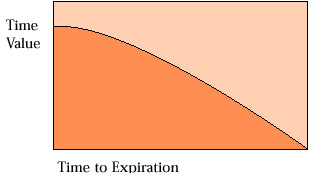Chapter 2: The Arithmetic of Option Premiums
At the time you purchase a particular option, its premium cost
may be $1,000. A month or so later, the same option may be worth
only $800 or $700 or $600. Or it could be worth $1,200 or $1,300
or $1,400. Since an option is something that most people buy with
the intention of eventually liquidating (hopefully at a higher price),
it’s important to have at least a basic understanding of the
major factors which influence the premium for a particular option
at a particular time. There are two, known as intrinsic value and
time value. The premium is the sum of these.
Premium = Intrinsic Value + Time Value
Intrinsic Value
Intrinsic value is the amount of money, if any, that could currently
be realized by exercising the option at its strike price and liquidating
the acquired futures position at the present price of the futures
contract.
At a time when a U.S. Treasury bond futures contract is trading
at a price of 120-00, a call option conveying the right to purchase
the futures contract at a below-the-market strike price of 115-00
would have an intrinsic value of $5,000.
As discussed on page 8, an option that currently has intrinsic
value is said to be "in-the-money" (by the amount of its
intrinsic value). An option that does not currently have intrinsic
value is said to be "out-of-the-money."
At a time when a U.S. Treasury bond futures contract is trading
at 120-00, a calloption with a strike price of 123-00 would be "out-of-the-money"
by $3,000.
Time Value
Options also have time value. In fact, if a given option has no
intrinsic value—because it is currently "out-of-the-money"—its
premium will consist entirely of time value.
What's "Time Value?"
It’s the sum of money option buyers are presently willing
to pay (and option sellers are willing to accept)—over and
above any intrinsic value the option may have—for the specific
rights that a given option conveys. It reflects, in effect, a consensus
opinion as to the likelihood of the option’s increasing in
value prior to its expiration.
The three principal factors that affect an option’s time
value are:
1. Time remaining until expiration. Time value
declines as the option approaches expiration. At expiration, it
will no longer have any time value. (This is why an option is said
to be a wasting asset.)

2. Relationship between the option strike price
and the current price of the underlying futures contract. The further
an option is removed from being worthwhile to exercise—the
further "out-of-the-money" it is—the less time value
it is likely to have.
3. Volatility. The more volatile a market is,
the more likely it is that a price change may eventually make the
option worthwhile to exercise. Thus, the option’s time value
and therefore premium are generally higher in volatile markets.
Past performance is not indicative of future results. Trading futures and options is not suitable for everyone.
There is a substantial risk of loss in trading commodity futures, options and off exchange forex.
|


